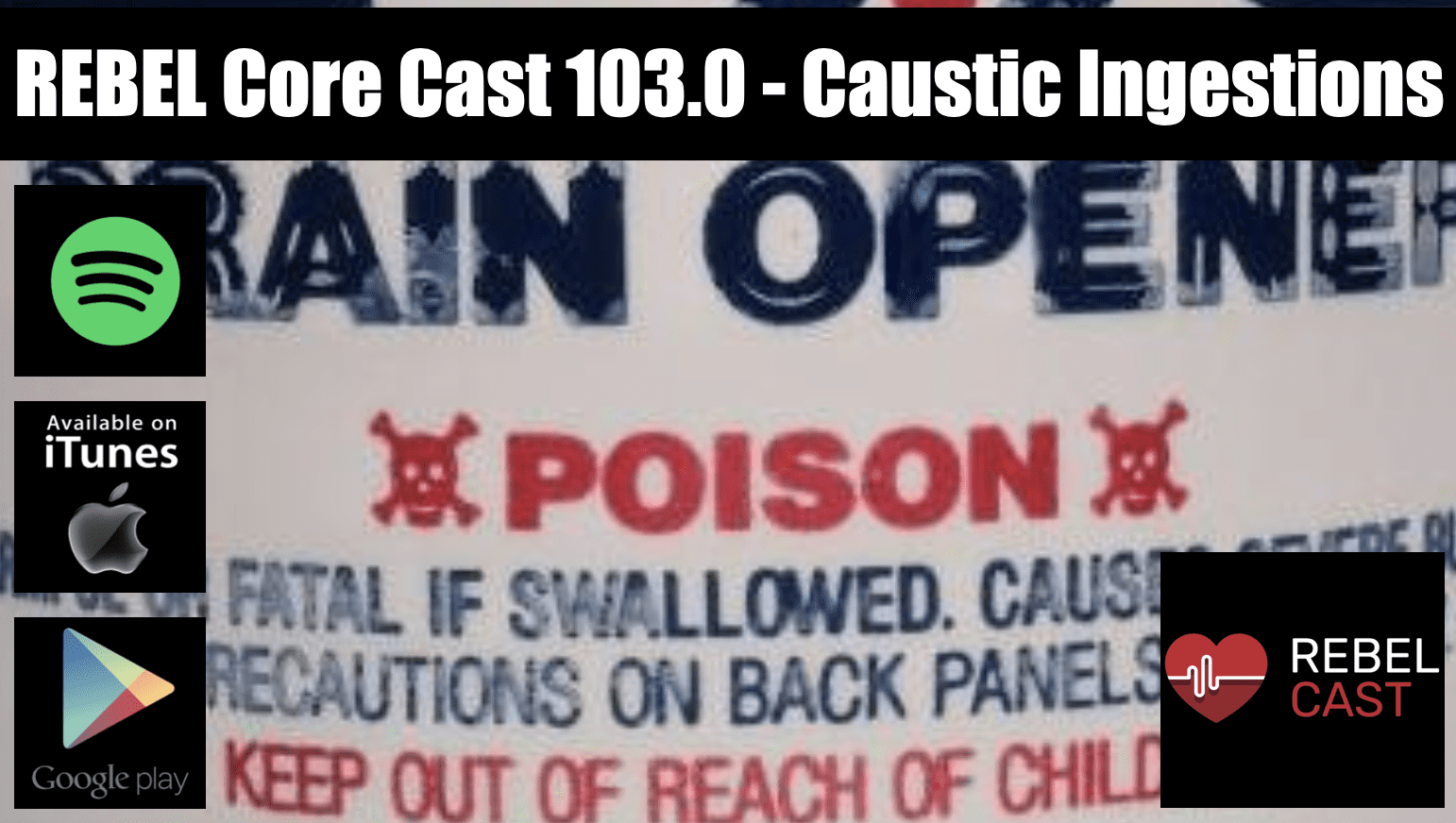
 Take Home Points
Take Home Points
- Caustics are substances that injure tissue upon physical contact. Caustic potential is not purely a function of pH.
- The decision to admit is dependent on the history and physical. Vomiting, drooling, and stridor are concerning. Stridor alone or 2/3 symptoms should warrant admission and gastroenterology consultation for potential endoscopy.
- The lack of oropharyngeal lesions does not have great negative predictive value in regards to evaluating the likelihood of internal gastrointestinal injury.
- Clinicians are encouraged to call their local regional toxicologist and poison control center whenever a caustic ingestion poisoning is suspected.
REBEL Core Cast 103.0 – Caustic Ingestions
Definition and Physiology
- Caustics are xenobiotics that cause damage (functional and histologic) upon contact with tissue. While they are often thought of in terms of acids and bases, desiccants and vesicants should also be considered as caustics.
- In the western hemisphere, commonly ingested household caustics include drain cleaners and hair straighteners (often sodium or potassium hydroxide), bleach (sodium hypochlorite), and toilet bowl or swimming bowl cleaners (concentrated acids such as hydrochloric acid) (Hoffman 2020)
- Recently, laundry-detergent capsules or “pods” have increasingly become a cause for concern given that they are often packaged in bright colors which tends to entice children and as a result leads to exploratory ingestions.
Clinical Manifestations
- Common acute manifestations after a caustic ingestion include oropharyngeal swelling, drooling, and emesis.
- Delayed presentation may include esophageal perforation leading to mediastinitis or event gastric or bowel perforation leading to peritonitis.
- Bleeding may ensue if a vessel erodes.
Management
- Always consider calling your local toxicologist or regional poison control center, as even substances with a neutral pH may have caustic potential.
-
Asymptomatic Patients
- A period of observation is generally warranted. 4-6 hours of observation after ingestion is generally indicated to ensure patients don’t develop airway or oropharyngeal injury and can tolerate PO.
-
Moderate Patients
- The vast majority of patients will present with a concerning history but clinically may look relatively well. In that population, it is essential to recognize that the absence of oropharyngeal lesions/burns cannot exclude the presence of gastrointestinal injury internally. In contrast, in patients with obvious injuries to their cheeks, lips, and oropharynx, the risk of visceral burns is higher (Previtera 1990)
- In patients who look well but have potentially ingested something dangerous, it is critical to assess for the following signs/symptoms: vomiting, drooling, and stridor. Patients with stridor alone or 2/3 of the aforementioned symptoms warrant admission for observation and GI consultation as those symptoms are predictive of serious gastrointestinal injury (Crain 1984)
-
Critical Patients
- Management is straightforward: low threshold to intubate if there are impending signs of airway compromise.
- General resuscitation with broad spectrum antibiotics and volume resuscitation if the patient appears to be septic.
References
- Hoffman RS, Burns MM, Gosselin S. Ingestion of Caustic Substances. N Engl J Med. 2020 Apr 30;382(18):1739-1748. PMID: 32348645
- Previtera C, Giusti F, Guglielmi M. Predictive value of visible lesions (cheeks, lips, oropharynx) in suspected caustic ingestion: may endoscopy reasonably be omitted in completely negative pediatric patients? Pediatr Emerg Care. 1990 Sep;6(3):176-8. PMID: 2216918.
- Crain EF, Gershel JC, Mezey AP. Caustic ingestions. Symptoms as predictors of esophageal injury. Am J Dis Child. 1984 Sep;138(9):863-5. PMID: 6475876.
Post Created By: Sanjay Mohan, MD
Post Peer Reviewed By: Anand Swaminathan MD, MPH (Twitter @EMSwami)
The post REBEL Core Cast 103.0 – Caustic Ingestions appeared first on REBEL EM - Emergency Medicine Blog.
